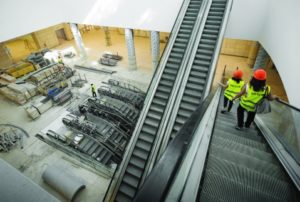
Escalators to the ticket purchase level at the new Israel railway station in Jerusalem. (Hillel Maeir/TPS)
By Mara Vigevani
As the escalators head down 80 meters below ground to the world’s fifth deepest railway station, the sound of traffic at one of Jerusalem’s busiest crossings gradually fades away.
The cacophony above ground is replaced by the sound of heavy tractors and vehicles and hundreds of laborers from Poland, Romania and Turkey working non-stop in a subterranean Tower of Babel.
At the entrance to the capital, between Jerusalem’s Central Bus Station and the International Convention Center, one of the country’s largest infrastructure projects is taking shape.
With departures every 15 minutes in each direction carrying up to 1,000 passengers, the new line will cut Tel Aviv and Jerusalem travel time from its hour-and-half-journey on the scenic route to Malha station, originally built by the Ottoman Turks, which will remain as a tourist attraction.
Some 40,000 passengers are expected to pass through the station every day.
The site is the Jerusalem railway station, where trains departing for Tel Aviv will arrive 28 minutes later as of April, 2018.
The direct rail link will include some 40 kilometers of tunnels, eight bridges and 56 kilometers of electrified track. A parking lot will be built adjacent to the station with 1,200 underground parking spaces.
There are four sets of 18-meter long escalators that will take passengers up and down three flights to and from the platforms.
In addition, three huge elevators, each of which can carry 33 passengers, descend to the platforms in only 25 seconds.
When the elevator doors open, without any natural light and with artificial lighting not yet operating, it is like entering a black and white movie.
The 72,000-square-meter station can also double as a nuclear shelter. It has two huge electric doors that can seal up to 2,500 passengers in a 220-square-meter corridor that can be transformed into safe refuge, providing supplies of water, food, and medicine for 48-hours.
During a tour of the site, Israel Railways spokesperson Lital Ventura said, “the trains will not produce any pollution due to the fact that they will be all electric.”
Electric trains are also much faster than diesel ones.
“Diesel trains travel about 130 to 150 kilometers per hour, while electric trains travel at speeds of 160 to 200 kilometers per hour. Electric trains are going to change Israel,” Ventura said.
The new station is just one piece of the puzzle planned by the Jerusalem Transportation Master Plan Team (JTMT). The plan also calls for a massive expansion of local public transportation.
“By 2026, we plan to build an additional 60 kilometers of light railway. That’s five more lines, 140 stations, 300 trains and 600 to 700,000 passengers per day. By 2040 there will be eight lines,” Shmuel Elgrabli, strategic advisor and spokesman for the JTMT said.
The budget for the new lines that will connect Jerusalem from North to South and West to East is estimated at $5.6 billion.
But don’t buy tickets just yet. Almost nine years on from commencement of the 1.8 billion Tel-Aviv-Jerusalem link, the state comptroller revealed in his annual report on October 25 that electrification of the line could be held up until late 2019.
















